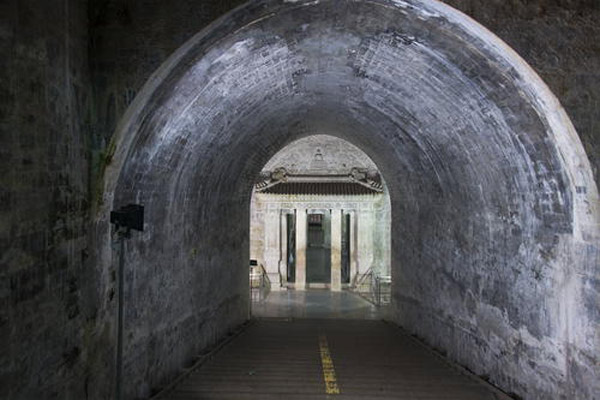Tomb of the Ming Dynasty - Qing Dynasty
Unesco's Scientific, Educational and Cultural Organization recognized the Royal Tomb of Minh - Thanh as a World Cultural Heritage in 2000.

Tomb of the Ming Dynasty - Qing Dynasty is a complex of tombs, tombs of kings, queens, pilots, princesses . belonging to two Ming and Qing dynasties of China. This population is scattered in many provinces / cities of China such as: Anhui, Jiangsu, Beijing, Liaoning, Hubei and Henan, distributed according to different historical periods.

Tomb of the Ming Dynasty - Thanh has a high historical value and is an important proof for the study of life, burial regimes, rituals as well as the construction techniques of the ancients. Not only that, the royal tomb of the Ming Dynasty - Thanh is also a typical evidence for China's political, economic, military, cultural, scientific and artistic research. Lang Dynasty royal tombs of Ming Dynasty - Thanh consists of many architectural works including important works such as Hien Lang, Dong Lang and Tay Lang of Thanh Dynasty.


Hien Lang in the Ming Dynasty, located in Chung Tuong City, Hubei Province, was built in the 16th century, the tomb of the 12th King Minh Dynasty. The tide at Hien Lang consists of the Amnesty Mausoleum, the Tomb of the Ancestors, and the electric and organic power. The bow zone is Phuong Thanh, Minh Lau, the holy stele, Bao Thanh and Bao Dinh . The front part is the center of daily sacrificial activity, behind it is the place where mandarins are located.



Dong Lang Thanh is located in the city of Tuan Hoa, Ha Bac province. From the construction of Dong Lang in 1661 until completion, it took 247 years. The scale of Dong Lang is very majestic and subtle, expressing the supreme ideology of the royal authority, showing off the royal authority and majesty. The selection and location of Dong Lang's design have fully utilized the theory of traditional Chinese feng shui, focusing on expressing the concept of the " heaven and human unity ". In terms of scale and quality of architecture, it is required to be majestic and subtle to express the supreme ideology of the royal authority, show off the authority and majesty of the royal family, thereby becoming a materialized symbol of royal authority . There are 15 grave burial sites with 160 people: the king, queen, prince and princesses . Among them are many important influential figures in history such as Queen Hieu Trang Van; Kangxi Emperor; Qianlong Emperor; From the Queen Mother .


The Western Tomb of Qing is located in Di County of Hebei Province, more than 100 km from Beijing is the second largest royal tomb of the Qing Dynasty. Tay Lang was built in 1730 and completed in 1915 (lasts 185 years). It has 16 clusters of tombs with 402 ancient architecture. These structures are basically based on the Qing Imperial Palace, the Forbidden City in Beijing.

Experts of the World Heritage Council assessed that: the Minh and Thanh mausoleums are not only rare living materials for the study of regulations on tombs, burial, rituals and techniques. and the architectural technology of the Ming and Qing dynasties, but also typical evidence for political, economic, military, cultural, scientific and artistic research of ancient China, valuable Important history, art and science, are the precious heritage of the Chinese nation and all of humanity.

Tomb of royal court of Ming Dynasty - Thanh is recognized by Unesco under the criteria (i), (ii), (iii), (iv), (vi).
Criterion (i): The harmonious construction of architectural populations in many different stages proves the creativity and arrangement of the former man's love.
Criterion (ii): The tombs in the royal tombs of the Ming - Qing Dynasty are the representatives where the traditions of the previous generations are the basis for the development of the next generation.
Criterion (iii): The architectural works in the royal tomb of Minh - Thanh are also outstanding evidence for cultural and architectural traditions in the hundreds of years of domination of two Chinese dynasties.
Criterion (iv): The architectural works in royal tomb of Minh - Thanh are suitable for the natural environment but still harmonize with people and are typical tombs of ancient Chinese society.
Criterion (vi): Royal tombs are also typical of beliefs about the afterlife in Chinese feudal society. At the same time, the characters buried here are all major influential figures in Chinese history.
- Image: Excavating the tomb of the post-Ming Dynasty
- Why did the Qing emperor all die in winter?
- The 3 most frightening locations of Cung Cung, visitors also feel
- Discovered a 300-year-old mysterious mummy in China
- Rare photos of how to organize the wedding of a noble Chinese family in Qing Dynasty
- Authentic image of Qing soldiers
- China discovered the ancient citadel of the Tang Dynasty built by Cao Bien
- Controversy surrounding the discovery of ancient tombs of the great saint Ton Ngo Khong?
- Great disaster in Beijing during the Ming Dynasty
- 8 most bloody casualties of human history
- The body was almost discovered in the ancient tomb
- Chinese aristocrat remains intact after 1,000 years
 Suzhou classic bonsai garden - China
Suzhou classic bonsai garden - China Chau Nguyen Dynasty
Chau Nguyen Dynasty Thai Son Mountain - World Wonder
Thai Son Mountain - World Wonder Ancient villages of Shirakawa-go and Gokayama
Ancient villages of Shirakawa-go and Gokayama